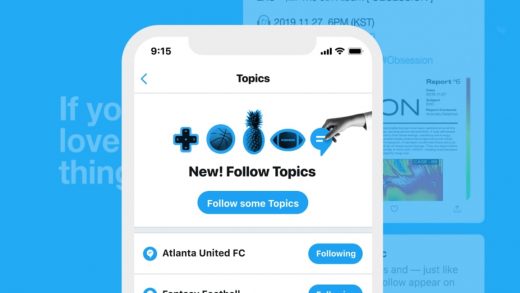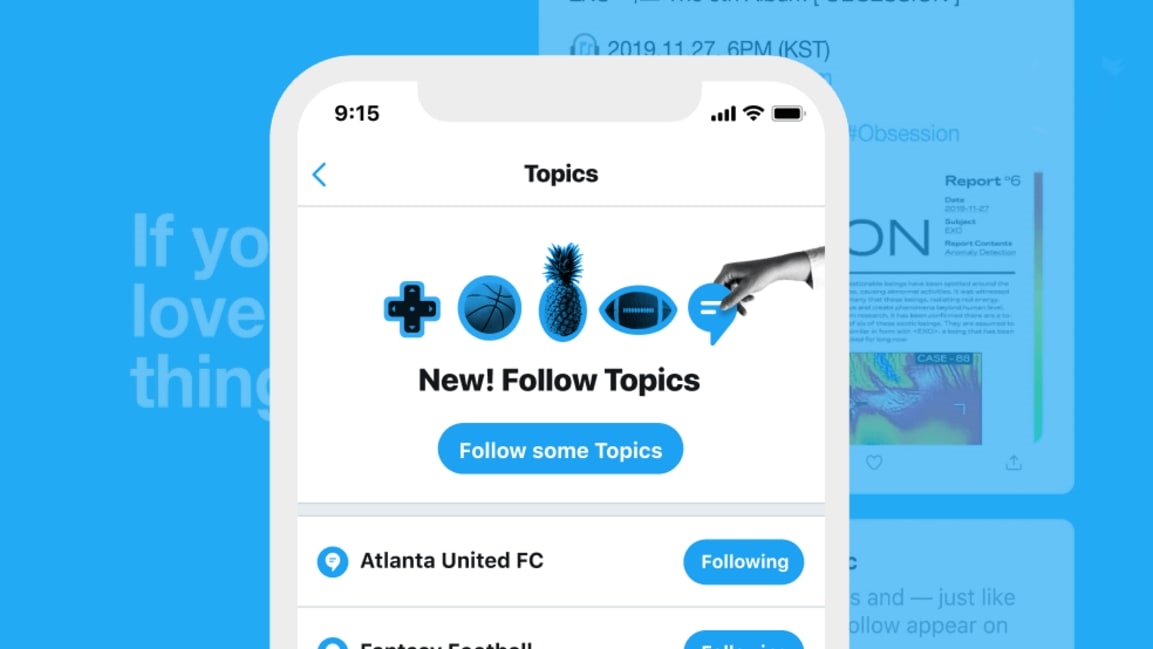Twitter’s big bet on topics and lists is just getting started
“People would hear about all the great stuff that happened on Twitter all the time, and they just couldn’t find it. It’s like, ‘Oh my God, did you see what’s happening on NBA Twitter?’ And people would search for ‘NBA Twitter’ and be like, ‘Is this it? Have I found it? Is it a hashtag or something?’”
The person describing a fundamental flaw with Twitter as we’ve known it isn’t some disgruntled user or carping pundit. It’s Steve Zimmerman, who, as a staff product designer at Twitter, is one of the people responsible for making the service approachable. If you’re a typical user, he says, “you have like five or eight interests that you care about, and you use Twitter to keep up to date with them.” But you’ve been left on your own to figure out who’s worth following for any given subject.
That started to change in November, when Twitter made it possible to follow topics as well as specific accounts. With this new feature, one tap lets you enrich your timeline with the best of NBA Twitter. Or WNBA Twitter. Or NCAA Twitter, or Twitter for any of the specific teams that make up these leagues. Or, for that matter, Star Wars Twitter, Fortnite Twitter, or Cardi B Twitter. Or knitting Twitter or birdwatching Twitter or dozens of other enthusiast Twitters that can be even tougher to tease out than the ones with enormous fan bases.
At the same time that Twitter has been rolling out topics, it’s been rethinking its lists feature. Introduced way back in 2009 as an early stab at topic curation, lists let users assemble feeds—they can be public or private—of whatever accounts they choose. But after being initially welcomed with a flurry of giddy enthusiasm, lists have largely languished—beloved by a few, ignored by the masses. Now Twitter is trying to make them easier to find and use, so users can help each other explore the service.
So far, Twitter has folded topics and the revised version of lists into its existing experience with enough subtlety that you may not have noticed them yet. But their basic form only hints at Twitter’s grand ambitions. With that in mind, I recently spent time at Twitter to speak with some of the folks responsible for hatching the new functionality, integrating it with the rest of the service, and charting its future.

[Photo: courtesy of Twitter]
One of those people was VP of product Kayvon Beykpour, the Periscope cofounder who has overseen the Twitter experience since mid-2018. “Going into 2019, we thought to ourselves, ‘What are the smallest set of really crucial initiatives then we can disproportionately focus on that can solve critical customer problems?,” he told me. Topics and lists made the cut.
Both features serve the overarching goal of connecting Twitter users with tweets they’ll want to see. In the past, accomplishing that has always felt like it involved a Catch-22: You’ve needed to follow people, and it’s tough to know who’s worth following among the service’s 145 million daily active users until you’ve already found and followed them. As thematic aggregations of tweets, topics and lists could be a far more efficient way to tune your own personal Twitter to your tastes.
“We really believe that if we give users explicit control over what shows up in their home timeline beyond just account follows, we can make that timeline a lot better,” says product director Angela Wise. Though Twitter has begun testing that belief with the first release of topics and some starter tweaks to lists, it’s a big enough idea to keep the company occupied for some time.
The time is right
Given that Twitter is coming up on the 14th anniversary of cofounder/CEO Jack Dorsey’s famous first tweet, it’s fair to wonder why the company is still in the process of figuring out something as important as navigation by subject matter. Twitter has long been dinged for moving at a leisurely pace when it comes to major changes to its platform, even when they’re as vital as helping people to explore the topics they care about.
Then again, whenever the company introduces anything new, some Twitter watchers reflexively bash its priorities. Oftentimes, skeptics argue that whatever energy Twitter put into something new should instead have been invested in tamping down on the harassment, hate, and trolling that have tarnished the experience for many users.
Beykpour has heard both criticisms. He argues that now is the right time to introduce topics and revitalize lists. “We decided to focus on it, because we thought we’d made enough progress in other areas, and we had enough wind in our sails as an organization to start making bigger bets,” he says. “And this is a really big bet. It’s something that will fundamentally evolve the product experience, that will change how Twitter looks and feels. It’s a tremendous technical investment for us, being able to understand how tweets map to different topics.”
When it comes to improving what Twitter calls the “health” of its platform, “I’m really proud of the progress we’ve made,” says Beykpour, adding immediately that “we’re by no means done.” He points to recent changes such as giving Twitter users the ability to hide replies on their timeline as evidence that Twitter is listening to users and coming up with creative ways to keep the time they spend on Twitter positive. Besides, giving people more power to control the topics that show up in their timelines is in itself an effort to make the service more personal and pleasant, and therefore more healthful.
Just answering the question “What is a topic?” was not that straightforward.
The introduction of topics and changes to lists have their roots in research Twitter began a couple of years ago, from surveys to in-home sessions with consumers. The data showed the company that keeping up with interests was not just the primary reason people used Twitter, but a scenario whose importance was still growing. By the start of 2019, “we started conducting some early concept testing with people saying, you know, ‘Hey, if you could follow a topic on Twitter, how would you feel?,’” says Daniel Machado, who was a staff researcher when I spoke to him (he left Twitter earlier this month). The reaction was enthusiastic.
In the context of Twitter, however, just answering the question “What is a topic?” was not that straightforward. Would people want to follow “sports,” or was that too general a theme? How about particular teams? Given the service’s association with instant commentary on fast-breaking news, a specific sporting match, or even a play within it, might count as a topic.
Twitter found its comfort zone somewhere in the middle of the continuum from overly broad to incredibly specific. “What we ultimately ended up referring to as ‘topics’ are these things that are evergreen and lasting pieces of information that we can continue to keep you informed about,” says Zimmerman.
Guided by data on the hottest subjects of conversation on Twitter, the product team started building out a list of hundreds of topics, gravitating toward the ones with the most mass appeal. “K-pop is a thing that breaks Twitter and trends all over the world,” says Machado. As such, it’s particularly well represented, with 56 acts having their own topic. There are 75 “celebrities,” from Adam Driver to Zendaya. Some other areas are still to be fleshed out: “Pets” presently lets you choose from cats, dogs, and horses—sorry, ferret fans—and “Fashion” has just one sub-item, “Fashion Models & Designers.”
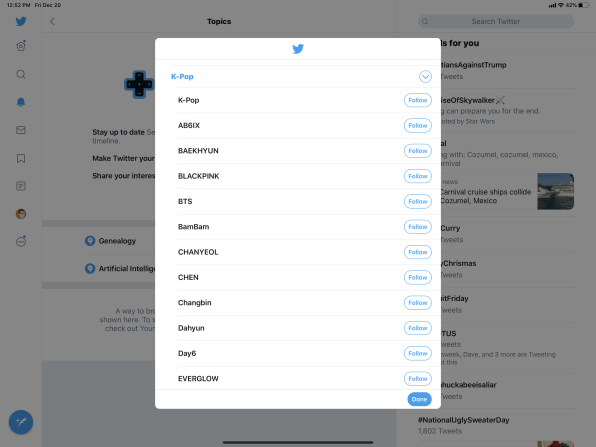
If a seemingly no-brainer topic is missing, there’s a good chance it’ll come along sooner or later; Twitter is adding more each week. “We’re starting out this product experience around a relatively narrow set of topics that we’ll expand constantly over time,” says Beykpour. “You can imagine a world where every long-tail niche topic you might be interested in, we’ll have a topic for.”
For now, however, one gaping hole in the list is intentional: the absence of anything relating to politics and world affairs. Giving the touchy nature of such matters—people are going to be unhappy with Twitter no matter how it incorporates them into topics—the company decided to postpone dealing with questions such as which elected officials might deserve their own topics or how to determine what a high-quality political tweet is. “We started with topics that potentially have lower societal cost … before we start to take on some of those more complex and sensitive topics,” says product manager Wally Gurzynski.
By inviting people to explicitly follow their favorite topics, Twitter will gain additional knowledge that could be used to target advertising more effectively—and indeed, its introductory text for the topic selector mentions ad relevancy. Expressing a standard tech-company sentiment for a major new feature’s goals, Beykpour says the emphasis for now is on nailing the core user experience. But he adds that “we think there’s tremendous opportunity to monetize [it] as well.”
It’s all in the tweets
In the end, the promise of Twitter’s topics lies in the individual tweets that people will see in their timelines. And so do the potential pitfalls. Machine language can handle the ongoing heavy lifting of separating exemplary tweets from chaff, though what the company is trying to accomplish is still new enough that the machines need help with quality control. “There’s quite a lot of technology to scale that, and quite a lot of humans in the loop to make sure that that content is healthy and relevant,” says Wise. Further improving the tweet-selection process is a major priority for 2020.
The key thing to understand is that topics aren’t just officially sanctioned Twitter lists, with the company compiling rosters of pertinent accounts and then shoveling them in their entirety into a user’s feed. If, like Beykpour, you’re into men’s tennis, you’ve always been able to follow other Twitter users who tweet a lot about the subject—because they play it, cover it, or just plain love it. But nobody tweets exclusively about men’s tennis. Topics are meant to be smart enough to ignore anything that’s, well, off-topic—even if the person doing the tweeting is Roger Federer.
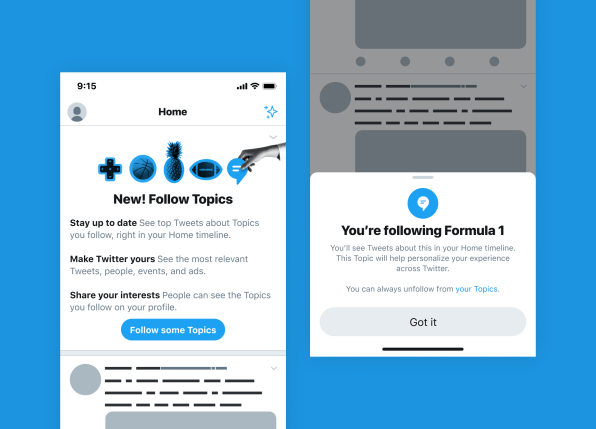
[Screenshot: courtesy of Twitter]
Conversely, topics should also identify worthy men’s tennis tweets even if they’re from people who haven’t achieved a huge measure of Twitter fame tweeting about the subject, and might not even do it all that often. “Absent this feature, I’m forced to make up kind of a strange trade-off,” says Beykpour. “I either follow them and see everything, or I don’t follow them and I don’t get the best men’s tennis experience.”
What makes a tweet interesting enough to flow into a topic? Metrics such as its likes and retweets factor into it, but “not all likes are equal,” says Gurzynski. Twitter aspires to make topics about something more meaningful than mere vitality. As Wise was fine-tuning the yoga topic, she notes, “there were a lot of tweets from famous people that said, ‘I did yoga today.” Which certainly is about yoga, but it’s not necessarily an interesting tweet about yoga.”
To pull tweets into a topic, Twitter is drawing on some of the technologies it’s honed since it began algorithmically sorting timelines in 2016. But topics also rely on techniques that the company has developed only more recently. “We only care about likes and retweets if we know the tweet is about the topic, and we know that the person who’s tweeting is known for tweeting about that topic,” says Wise.
Whether topics transform how you experience Twitter may depend in part on how voraciously you already guzzle from its fire hose. They should be especially valuable for new users, who have always found it “quite intimidating to set up the perfect Twitter experience,” acknowledges Beykpour. Now Twitter asks newbies to choose some topics as part of the sign-up process, so their timeline reflects their interests from the get-go.
Me, I’ve been on Twitter for almost 13 years and have already followed almost 5,000 people. That has rendered the 20 topics I’ve added all but invisible in my timeline. (Tweets that appear as part of a topic you’re following are flagged as such, just as other tweets are marked as having been retweeted or liked by someone you follow.) Of course, as a grizzled veteran, I’m in less urgent need of an assist from topics than someone who’s just getting started or is having trouble figuring out the service. By creating a new account and following only topics, I was able to see them—and they were indeed reasonably interesting stuff, in non-overwhelming quantities.
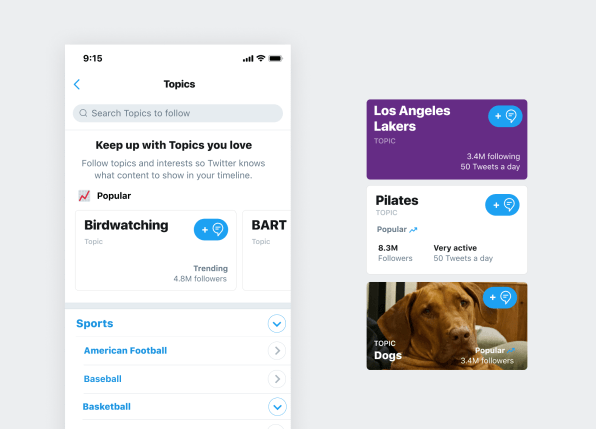
[Screenshots: courtesy of Twitter]
Along with incorporating topics into the sign-up process and letting anyone follow them via the topic browser, Twitter has also integrated them into Twitter search, where a relevant topic—and a “Follow” button—are often the first result. That should go a long way toward addressing Zimmerman’s example conundrum involving the mystery of “NBA Twitter.”
Though topics in their initial incarnation are already solving problems for Twitter, they’re also raising new ones. “One of the things that we are being really cognizant of is the fact that there are topics that are people, so Beyoncé could be a topic as well as an account,” says senior product designer Tegan Mierle. “It’s important to distinguish between the two of those things, and it’s actually a pretty tricky design challenge.”
One frequent piece of early critical feedback, Twitter says, is that the only way to gauge a topic is to follow it. With that in mind, the company’s designers are readying cues to give you a sense of what you’re going to get, including elements such as related hashtags, estimates of daily tweet volume, counts of followers and contributors, and badges such as “Popular” and “Engaged.”
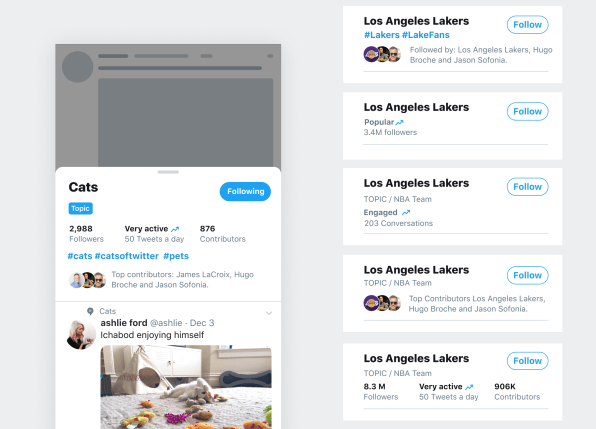
[Screenshot: courtesy of Twitter]
Also in the works is a way to see the stream of tweets for any other topic, all in one place and with no following required. That would help you get a feel for a topic before committing. But it should also open up an entirely new, more organized way of consuming Twitter, as a tidy bento box sorted by subject instead of the gumbo-like mishmash of the timeline.
Beykpour says that this topic reader will be “really cool.” But he stresses that Twitter wanted to start by bringing topics to the place where users spend most of their time rather than expecting them to adjust long-standing habits: “It’s easy to forget the power and scale that the home timeline has as a destination.” (One major aspect of Twitter that’s already organized by subject—the news-centric Moments—is a section unto itself, which might help explain why its impact on the service hasn’t exactly been transformative.)
Lists, reimagined
If Twitter’s topics still feel like a very early take on a powerful proposition, lists haven’t even gotten that far—despite the fact that they’re over a decade old. After years of leaving them in a state of benign neglect, Twitter says it’s committed to bringing them to the forefront, an exercise it’s given a code name: “Project Spheres.”
The fact that lists in their current form were a musty throwback to an earlier era didn’t mean that they were purely vestigial, like a Facebook poke. In fact, Twitter saw lists as being full of unfulfilled promise. “Even though we haven’t worked on lists in a while, people really care about this,” says senior product designer Joe Tutterow. “There are a lot of passionate lists users within these walls as well as outside of these walls.”
Much of Twitter’s progress on lists has been in the form of internal conversations, explorations, and experiments.
Lately, Twitter has been making relatively modest changes to lists to make them more inviting and intuitive. “A lot of the work that we’ve done is trying to understand what kind of lists you’re creating and then recommendations of new people to add to that list that just keep more refined as you keep interacting with it over time,” explains Tutterow. The company, he says, has also focused on “simple UX wins, like making ‘Add’ and ‘Remove’ more prominent actions.” In September, it started letting you pin lists to the top of your timeline, a simple way to influence the tweets you see when you peruse the service.
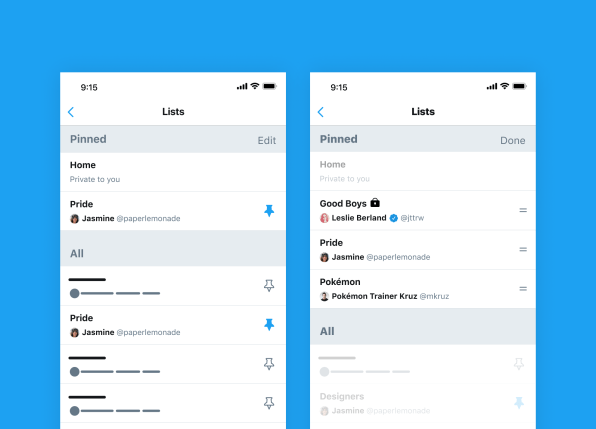
[Screenshot: courtesy of Twitter]
But much of Twitter’s progress to date on its reboot has been in the form of nearly a year’s worth of internal conversations, design explorations, and experiments that aren’t yet ready to deploy to millions of people. And a large chunk of that has centered on exposing people to the lists that other users have been crafting. “There’s no way to discover them unless you manually go and find them, which is really difficult,” says Mierle.

[Photo: courtesy of Twitter]
Twitter’s solution involves building a marketplace for lists—which, in early drafts, even looked much like the app stores on iPhones and Android phones, though more recent designs have swung back to a look more consistent with the rest of Twitter. “We’re working on making it possible to actually see the full universe of all these user-generated timelines so that you can share them with other people and you can subscribe to other people’s,” says Gurzynski.
Another area where Twitter plans to do more work is on personalization of list pages. For now, they’re topped by one of a few stock visual collages created by Sandra Garcia, a designer in Twitter’s New York office. (These collages also appear in the card that appears when you share a list.) But the plan is to let people upload their own header images, as you can already do for your Twitter account. Tutterow says that a list’s page “will eventually become a canvas for user expression for the list creator.”
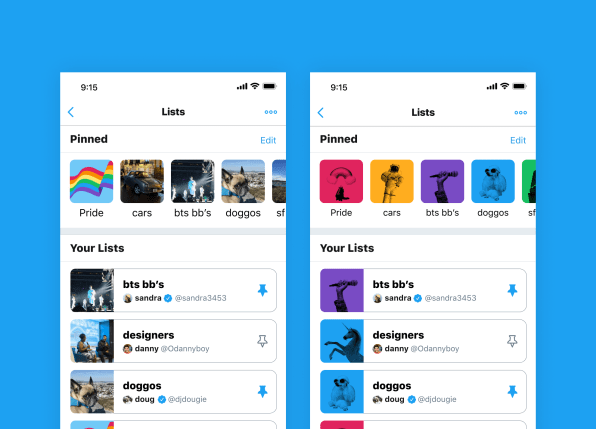
The shape of Twitter to come
For Twitter, topics and lists are not just a series of launches but a rare inflection point. Beykpour calls them “a big mental modal change for customers that we think is really exciting. And also a mental modal change for us around how we craft the product experience.” Twitter’s thinking on where that experience could go has already sprinted well past its current form and immediate future.
During my visit to the company’s San Francisco headquarters, I got to peek at tantalizing boards plastered with the design team’s early, unfettered visual brainstorming on where the service could go. It explored what-ifs such as the ability to follow a place—say, San Francisco—on Twitter. And then to specify which aspect of that place you cared about most—such as its food, music, and art—so that your San Francisco Twitter might be strikingly different than someone else’s.
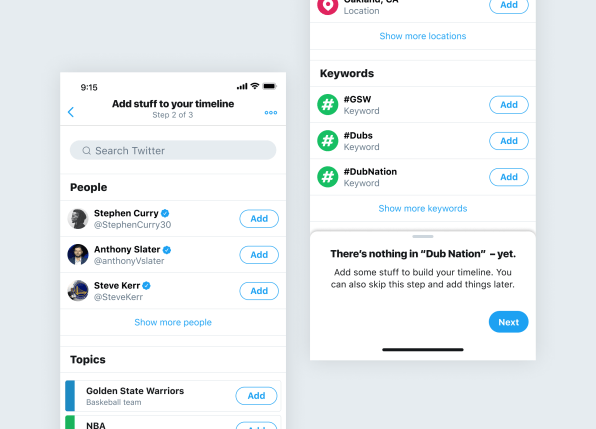
[Screenshots: courtesy of Twitter]
Also among Twitter’s still-unexecuted ideas is a list builder that would step you through adding multiple elements to a list—not just user accounts, but also topics, hashtags, and locations. “We’re actually still open to a lot of the ideas that we had,” says Tutterow. “It’s just that we needed to focus initially on what would bring the most value to people.”
According to Zimmerman, one early sign that the topics project has been on the right path came when CEO Dorsey looked at a rough draft and commented that it looked like the Twitter he’d envisioned from the start. More recently, as changes have reached users, Zimmerman says that their reaction has been similar: “This feels like something Twitter should always have had.” If future revisions to topics and lists continue to strike that balance, they could take the service in some directions that are pretty radical—yet somehow comfortably familiar.
(19)

